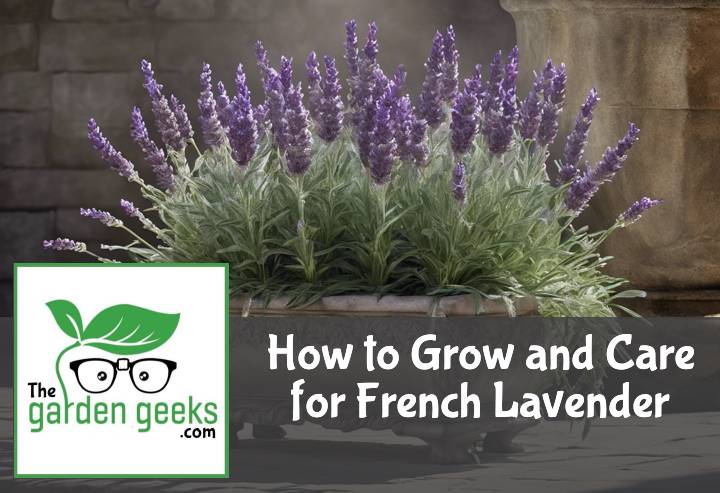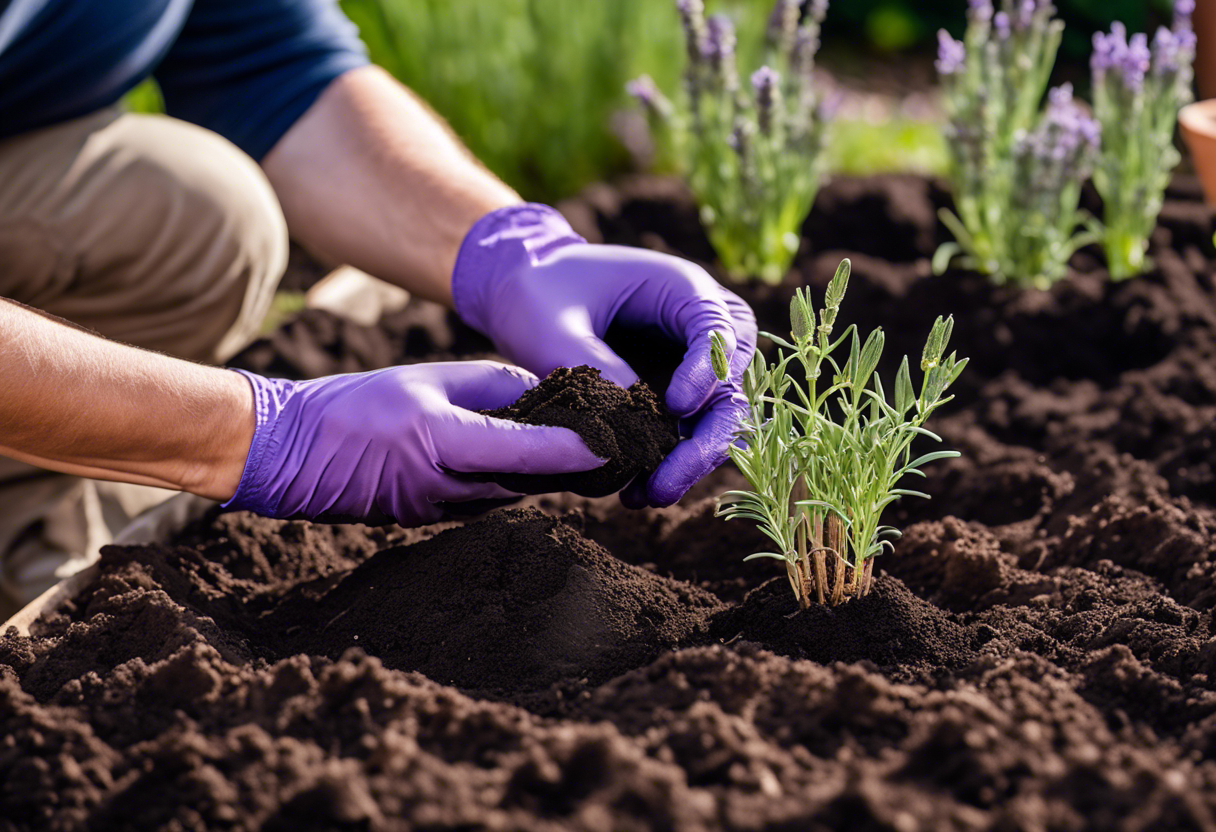Hello there, green thumbs! Ever fancied having a little piece of Provence in your backyard? Well, you’re in luck because today we’re talking all about How to Grow and Care for French Lavender. This aromatic beauty not only jazzes up your garden with its vibrant purple hues but also fills the air with a calming fragrance that’s pretty much summer in a scent!
You might be thinking, “Lavender? Isn’t that a bit… finicky?” Fear not! With our tips and tricks, you’ll have your own mini lavender field thriving in no time. So dig out those gardening gloves and let’s get started! Keep reading about How to Grow and Care for French Lavender.
Key Takeaways
- French Lavender thrives in well-drained soil and full sun exposure.
- It requires minimal watering, only when the topsoil is dry.
- Pruning should be done in late summer or early fall to promote bushy growth and prevent woody stems.
- Fertilize lightly in spring with slow-release pellets for best results.
- Protect plants from harsh winter conditions by moving pots indoors or mulching around garden plants.
- Monitor regularly for pests like aphids and treat with organic insecticides if necessary.
What is French Lavender?
Ah, French Lavender! This plant, known scientifically as Lavandula stoechas, is a total showstopper. It’s like the supermodel of the lavender world – it stands out from the crowd and knows how to make an entrance.
Origin and Characteristics of French Lavender
Now let’s talk about where this beauty comes from. The origin of French Lavender is none other than the sunny Mediterranean region. That’s right, this plant is a sun-loving, heat-tolerant diva that thrives in warm climates.
What sets French Lavender apart are its unique features. Unlike your average Joe lavender, this one sports dark purple flowers that sit atop leafless stems. And those cute little tufts on top? They’re not just for show – they’re bracts, or modified leaves.
But wait, there’s more! The leaves of the French Lavender plant are not your typical green either. They’re grayish-green and covered in fine hairs, giving them a soft and fuzzy appearance. Talk about being different!
Differences Between French Lavender and Other Varieties
When it comes to comparing lavenders, you’ll find that each variety has its own charm. But what makes our star, the French vs English lavender, stand out?
Well for starters, their looks are quite different. While English lavender has long slender stalks with rounded flower heads, French lavender flaunts chunky flower heads topped with adorable bunny-ear-like bracts.
And then there’s the aroma – oh boy! If you thought all lavenders smell alike, think again! The scent of French lavender is less sweet compared to English varieties; it has a more robust and complex fragrance which some describe as “camphor-like”.
Lastly let’s talk about growth habits. Most lavenders grow into neat, rounded mounds. But not our French friend! It’s more of a free spirit, growing in a more relaxed and sprawling manner. So if you’re looking for something a little different to add to your garden, French Lavender might just be the ticket!
How to Plant French Lavender?
Let’s dive into the nitty-gritty of planting French Lavender. It’s not rocket science, but a few key steps can make your lavender cultivation journey a walk in the park.
Choosing the Right Location
First things first, you gotta find that sweet spot for your lavender garden setup. French Lavender is a bit of a sun worshipper, so an ideal location for lavender is somewhere with plenty of sunlight exposure.
Now, don’t forget about drainage! These plants hate wet feet. So, ensure your chosen location has good drainage to prevent waterlogging and root rot.
Preparing the Soil
Next up on our how to grow and care for French Lavender guide is soil preparation. The secret sauce here is well-draining soil with a pH level slightly on the alkaline side.
Don’t worry if your soil isn’t naturally like this – you can always add some lime to increase its pH level. And remember, these plants are native to the Mediterranean region where soil nutrients aren’t exactly abundant. So don’t go overboard with fertilizers!
Planting the Seeds or Seedlings
Alrighty then! You’ve got your location and your soil ready – it’s time for some lavender propagation action! If you’re planting seeds, sprinkle them lightly over the surface of the soil and cover them with a thin layer of sand.
If you’re growing lavender from seedlings, dig holes deep enough to accommodate their roots without bending them. Place each seedling in its hole and backfill with soil until it’s level with the ground surface.
And voila! You’re now officially in the business of growing lavender plants!
How to Care for French Lavender?
When it comes to French Lavender care, there are a few key things you need to keep in mind. Watering, pruning, and dealing with pests and diseases are all part of maintaining French Lavender.
Watering Requirements
First off, let’s talk about watering French Lavender. These plants prefer well-drained soil and don’t like to have their roots sitting in water. So, you want to make sure you’re not over-watering them.
On the flip side, under-watering can also be detrimental. If your lavender plant isn’t getting enough water, it might start to wilt or turn yellow. It’s all about finding that sweet spot when it comes to lavender hydration needs.
Pruning Techniques
Next up is pruning. Pruning French Lavender is essential for promoting growth and maintaining its shape. You’ll want to trim back the plant after it flowers to encourage more blooms.
The best time for lavender trimming is in late summer or early fall. This gives the plant plenty of time to recover before winter sets in. Remember, when it comes to when to prune lavender, timing is everything!
Dealing with Pests and Diseases
Last but not least, we have pests and diseases. Like any plant, French Lavender can be susceptible to certain pests like aphids or diseases such as root rot.
Preventing these issues starts with proper care – healthy plants are less likely to succumb to pests or disease. But if you do notice something amiss with your lavender plant, don’t panic! There are plenty of ways for treating lavender diseases and keeping those pesky pests at bay.
In conclusion, knowing how to grow and care for French Lavender involves understanding its specific needs and being vigilant about potential problems. With a little love and attention, your lavender plant will thrive!
When and How to Harvest French Lavender?
Harvesting French Lavender is a bit like baking a soufflé. Timing and technique are everything! If you’re wondering when the best time to harvest lavender is, or what the top-notch lavender harvesting techniques are, you’ve come to the right place.
Identifying the Right Time to Harvest
First things first, let’s talk about timing. The optimal lavender harvest time isn’t just about looking at your calendar and picking a date. You need to be observant of your plant’s health and the weather conditions too.
Your French Lavender will give you signs when it’s ready for harvest. Look out for buds that are just starting to open – that’s your cue! But remember, if Mother Nature decides to throw a tantrum with bad weather, it might be best to wait it out.
Methods of Harvesting
Now onto the fun part – harvesting! There are several lavender harvesting techniques that can help ensure you don’t harm your plant or hinder its future growth.
One popular method involves using sharp shears or scissors (no rusty garden tools here please!) and cutting long stems above the woody part of the plant. This not only gives you beautiful long-stemmed lavender for bouquets but also helps keep your plant healthy for future blooms.
Another technique is selective harvesting where you pick individual stems instead of cutting large bunches at once. This method takes more time but can help preserve your lavender during harvest and ensure continuous growth throughout the season.
Remember folks, how to grow and care for French Lavender doesn’t end with planting and watering – harvesting is just as important!
How to Use Harvested French Lavender?
Once you’ve mastered how to grow and care for French lavender, it’s time to reap the benefits. The harvested French lavender can be utilized in many ways, but first, let’s talk about drying and storing.
Drying and Storing
After harvesting your lavender, the first step is drying. Spread out the harvested French lavender on a flat surface in a cool, dark place. This helps maintain its aroma.
The process of drying French lavender usually takes about two weeks. You’ll know it’s ready when the buds are dry to touch but still fragrant.
Next up is storing. Place your dried lavender in an airtight container or bag. This method of storing harvested lavender ensures longevity.
Remember, maintaining aroma is key! So keep that container away from direct sunlight and heat sources.
Common Uses of French Lavender
Now that you’ve got your dried lavender, what do you do with it? Well, there are plenty of aromatic plant uses for this versatile herb!
One popular use is aromatherapy. A few sprigs of French lavender can transform your bath into a spa-like experience. That’s right – aromatherapy with lavender isn’t just for fancy spas!
But don’t stop at aromatherapy! The culinary uses of lavender are also worth exploring. Add some dried buds to your favorite tea or bake them into cookies for a unique flavor twist.
And lastly, don’t forget home decor! A bouquet of dried French lavender not only looks pretty but also keeps your home smelling fresh. Now that’s what I call multi-tasking – home decor with French Lavender at its best!
To Wrap Up
In the dance of gardening, French lavender is your reliable partner, always ready to twirl in tune with your green thumb. We’ve waltzed through How to Grow and Care for French Lavender, from seed sowing to snipping blooms.
So, put on your gardening gloves and let’s tango with nature! Remember, every plant whisperer started as a rookie. It’s time to grow your own fragrant piece of Provence at home.





